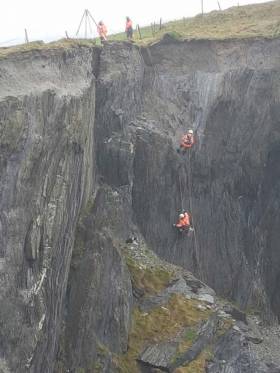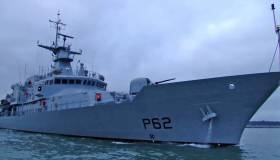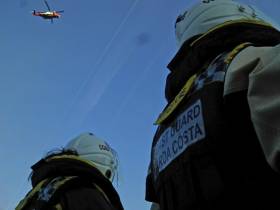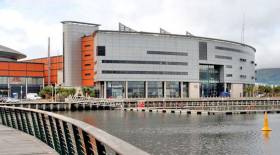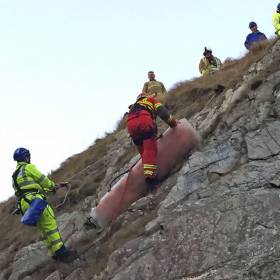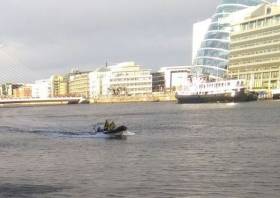Displaying items by tag: Rescue
Dog Rescued From Coastal Cliff Face In West Cork
#Coastguard - Goleen Coast Guard raced to the rescue of a dog trapped on a coastal cliff face in West Cork yesterday morning (Wednesday 22 February).
As BreakingNews.ie reports, two coastguard climbers set up a rig to abseil down to the border collie, named Boo, who had slipped down the cliff at Castlepoint near Schull.
“All went according too plan and boo was safely brought back to her owners again,” said a Goleen Coast Guard spokesperson.
Youghal Lifeboat Rescues Man Found Clinging To Kayak
#RNLI - Youghal RNLI has rescued a man who was found clinging to his kayak yesterday afternoon (Sunday 19 February) after he was in the sea for up to 45 minutes.
The volunteer crew was requested to launch their inshore lifeboat at 2pm after a member of Youghal Coast Guard who was driving past Redbarn beach observed what he thought to be someone in trouble in the water.
The lifeboat, helmed by Patsy O’Mahony and with crew members John Griffin, Eddie Hennessy and Martin Morris onboard, launched at 2.08pm and arrived on scene four minutes later, where they found the kayaker had got into difficulty one mile from the beach.
Weather conditions at the time were described as good, with a Force 2-3 north-westerly wind. The tide was falling and the water while calm was cold.
On scene, the lifeboat crew observed the kayaker clinging to his board. He had been unable to get back into the seat on top of the kayak and was showing signs of hypothermia after being immersed in the cold sea for up to 45 minutes.
The casualty was quickly recovered from the water and administered casualty care on the lifeboat and back at the lifeboat station until a doctor from the East Cork Rapid Response unit arrived. The kayaker was then transferred by ambulance to Cork University Hospital.
Speaking following the callout, Youghal RNLI lifeboat operations manager Derry Walsh said: “The kayaker, who was wearing a lifejacket when he got into difficulty this afternoon, had been in the water for a long time before he was spotted and he was suffering from hypothermia when we reached him. Time was of the essence and I have no doubt that a life was saved.
“I would like to commend the member of the public and the member of the coastguard unit here in Youghal who spotted the kayaker in difficulty and raised the alarm. Our crew responded rapidly and used their skills and training to administer casualty care. The kayaker was lucky today and all at Youghal RNLI would like to wish him a speedy recovery following his ordeal.”
Walsh added: “We would always encourage everyone taking to the sea to respect the water. Always carry a means of calling for help and keep it within reach. Wear a personal floatation device. Check the weather and tides. Tell someone where you are going and when you will be back. Wear appropriate clothing for the conditions and your trip.”
Man Recovered From Shannon After Leaving Taxi On Limerick City Bridge
#Rescue - Swift water rescuers from the Limerick Fire Service raced to the aid of a man from the River Shannon in the city centre last night (Friday 10 February).
As BreakingNews.ie reports, the casualty had entered the water at Shannon Bridge after leaving a taxi on the bridge around 10pm.
Passers-by threw the man a life buoy which kept him afloat till the rescue boat arrived just minutes later, recovering him to the slipway at St Michael's Rowing Club for treatment before transfer to hospital.
Naval Service Assists In Yacht Rescue Off Cork Harbour
#Rescue - LÉ James Joyce was called on to rescue a man from a yacht in difficult conditions off Cork Harbour yesterday evening (Thursday 9 February).
As RTÉ News reports, the Naval Service OPV was diverted from a routine patrol to retrieve the solo yachtsman from his vessel, which was taking on water some 16 nautical miles southwest of Roches Point.
Waterford’s Irish Coast Guard helicopter Rescue 117 was also dispatched to airlift the yachtsman to dry land in Cork.
Woman Airlifted To Hospital After Injury At Lough Gur
#Rescue - Shannon’s Irish Coast Guard rescue helicopter airlifted an injured woman to hospital from the shores of Lough Gur yesterday evening (Saturday 4 February).
As BreakingNews.ie reports, the woman had been walking with family next to the Co Limerick lake when she sustained a leg injury in a fall on uneven ground.
Coastguard Helicopters In Monday Morning Medevacs
#Coastguard - Irish Coast Guard helicopters were called on for two separate evacuations from fishing vessels yesterday morning (Monday 16 January).
In the first incident, Waterford-based Rescue 117 airlifted a fisherman who had suffered an injury on board his vessel to University Hospital Waterford.
On the same morning, Rescue 115 from Shannon was tasked to retrieve a casualty from a fishing vessel some 120 miles west of Kerry Head and transport him to University Hospital Limerick.
MEDICO Cork, based at Cork University Hospital’s A&E department, provided advice for both coastguard medevacs.
Belfast Policeman Praised For Rescue Of Woman From Water At City Arena
#Rescue - A Belfast Harbour policeman jumped into action on Sunday night (8 January) to rescue a young woman from the waters behind the city’s SSE Arena, as BelfastLive reports.
Police constable and lifeboat volunteer Scott Harkins was part of a team of emergency responders who went to the aid of the woman, in her 20s, who was visiting Belfast with family for an ice hockey game.
Constable Harkins was first on scene and wasted no time in pulling on a lifejacket and leaping into the cold waters of Abercorn Basin to recover the casualty and keep her afloat at the quayside.
BelfastLive has more on the story HERE.
Bangor Lifeboat Saves Swimmer In Ballyholme Bay
#RNLI - At 8.10am this morning (Wednesday 28 December), Bangor RNLI’s volunteer crew responded to a request from HM Coastguard to rescue a young man reported to be in difficulty while swimming 200 metres off the shore in Ballyholme Bay.
The alarm was raised by Ards and North Down council employee Mark Pollock as he was working in Banks Car Park. Hearing faint shouts, he initially thought it was someone calling for their dog, but persevered looking in the sea until he became aware that there was someone in the water.
Bangor RNLI’s volunteer crew responded within minutes and made their way to Ballyholme Bay.
Helmsman James Gillespie said later: “On arrival, the early morning light made it difficult to see, but fortunately the water was flat calm, and on scanning the area I saw a slight movement as the casualty raised his hand.”
Heading quickly to the scene, crew member Johnny Gedge entered the water to support the casualty, who was only just conscious, until he could be lifted on board the lifeboat, where crew members Joanne Heasley and Jack Irwin put their casualty care training to good use.
Gillespie added: “Our extensive training in casualty care is invaluable at a time like this. Because of this, we know the importance of not trying to warm the patient too quickly as this can cause cardiac arrest.
“Instead, we made the patient safe, and prevented further cooling, and returned as quickly and safely as we could to the lifeboat station where an ambulance and paramedics were waiting to take over.”
The patient, who is thought to be in his late 20s, was wearing only tracksuit bottoms, a T-shirt and socks, and it is unknown why he was in the water.
A shocked Pollock said: “I am just delighted that I heard his calls, and hope he makes a full recovery.”
Speaking after the ambulance left to take the patient to hospital, Bangor’s lifeboat operations manager Kevin Byers said: “I understand from talking to medical personnel at the scene, that only five minutes more in the water would have been fatal, and that the crew took exactly the right actions to give this young man the best chance of a full recovery.
“I am always proud of my team, but their response this morning was magnificent. Not just the four crew members on the boat, but the many others who responded to their pagers and were prepared to do whatever they could to help.”
Portaferry Lifeboat In Multi-Agency Rescue Of Man In Ardglass Cliff Fall
#RNLI - Volunteers from Portaferry RNLI went to the aid of a man who had fallen down a cliff at Ardglass Golf Club on the Co Down coast yesterday (Tuesday 27 December).
The Portaferry lifeboat, an inshore Atlantic 85, launched at 2.55pm just minutes after the launch request from the coastguard to join a multi-service response which included the Northern Ireland Fire Service Specialist Rescue Team, coastguard units from Portaferry, Newcastle and Kilkeel, the PSNI, Northern Ireland Ambulance Service and Rescue 936, the HM Coastguard helicopter from Carnarvon in Wales.
According to Independent.ie, it’s understood that the casualty had slipped down a 30ft gorge at the Ardglass golf links around 2.20pm.
Arriving on scene at 3.17pm, one of Portaferry’s volunteers went ashore to offer assistance to the other members of the emergency services already attending the casualty.
The decision was taken to bring the man to the top of the cliff, where a landing area had been prepared for the rescue helicopter to airlift him to Belfast City Airport for transfer to Royal Victoria Hospital. Portaferry RNLI remained on scene while the casualty was recovered.
Man Rescued From Liffey On Christmas Morning
#Rescue - Gardaí and Dublin firefighters rescued a man in his 20s from the River Liffey in Dublin’s Docklands on Christmas morning.
According to the Dublin Fire Brigade Twitter account, the man was kept afloat by gardaí with a life buoy till he was recovered by the fire service rescue boat at Sir John Rogerson’s Quay shortly before lunchtime yesterday.
1 person taken from the #Liffey by our rescue boat. @GardaTraffic used life buoy to keep person afloat, John Rogersons Quay #Dublin #fire pic.twitter.com/yQDBVxw7vO
— Dublin Fire Brigade (@DubFireBrigade) December 25, 2016
In other rescue news, TheJournal.ie looks at the Irish Coast Guard’s operations nationwide, co-ordinating the 1,000 volunteers who “face peril on every call out”.


























